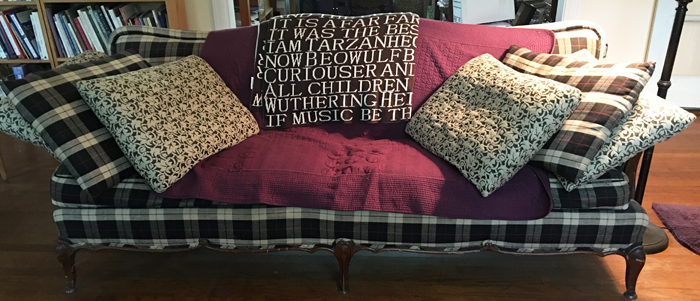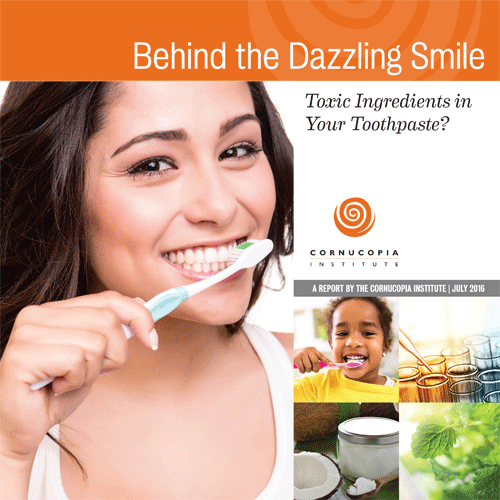
Submitted questions will be posted with my response by the following Tuesday or before.
Submitted comments will be moderated and approved within 24 hours.
Non-toxic pad under dining room table cloth
Question from Melanie
Hi Debra,
I hate vinyl, but need a thin pad to go under my dining room tablecloth.
I have searched the Internet thinking I could find latex or rubber padding but was not successful. Thoughts?
There has got to be something less toxic than vinyl…
Thanks so much, Melanie
Debra’s Answer
First, for those who don’t know why you might need a dining table pad…
If you have a nice wood dining table, it can be damaged by heat, scratches, and spills. A pad can protect the surface of your table from these accidents.
This is good for the table, but may not be so good for health.
The industry standard is to use vinyl and other possibly toxic materials and adhesives to make these pads.
There seem to be two types:
* solid, about 11/2” thick
* flexible, like a table cloth with thin padding.
The industry standard is to use vinyl and other possibly toxic materials and adhesives for both,
So the challenge here is to come up with some type of padding that will protect the table. I’m thinking if we can find a nontoxic foam in a thin layer, that should do it. And then put a tablecloth on top.
I actually did find something I think will work, but haven’t tested it.
There’s a website called Foam Order that sells thin sheets of foam made from EVA or polyethylene. Either of these would be fine to use. I don’t know if these are waterproof, however you can get it as thin as 1/8”. Call them and ask if this would meet your needs and let us know.
If it’s not waterproof, you could add a waterproof layer of something else. But this would give you the padding.
FDA Orders Removal of Antibacterial Triclosan From Consumer Soaps
The Food and Drug Administration (FDA) has finally told manufacturers they can no longer put triclosan in consumer soaps.
The FDA says antibacterial do little or nothing to make soap work any better and the industry has failed to prove they are safe.
Manufacturers have one year to comply.
Triclosan is still allowed as an antibacterial in other consumer products.
NBC News: FDA Orders Antibacterials Removed From Consumer Soaps
Listen to these shows on Toxic Free Talk Radio about antibacterials:
TOXIC FREE TALK RADIO: How Antibiotics and Antibacterials are Compromising Our Health
TOXIC FREE TALK RADIO: The Dangers of Antimicrobials and How to Choose Products Without Them
Bar vs Bottle — How Do You Buy Your Soap?
An interesting article entered my email inbox the other day from the environmental blog Treehugger.
It was about the change that’s occurring in the way people buy soap.
Bar soap sales are declining and liquid soap sales are gaining.
I was sorry to read this. From a toxics viewpoint, soap is one of the few products that can be very pure.
I love to buy soap from a local soap maker who doesn’t even put a wrapper on the soap. They just stamp the information right into each bar. Whenever I drive in that direction, I stop and buy a few bars.
One of my pleasures in life is buying all different kinds of handmade soaps at various craft fairs and trying them out.
But I can understand about soap in a bottle.
Reading about this, I took a conscious look at whether I was using bar or bottle soap. I hadn’t really thought about it.
What I observed was that I use bar soap in the shower and bathroom sink, and liquid soap in the kitchen.
For me, the issue is soap melting all over the soap dish. In the kitchen I often need to wash my hands because I have been cutting up chicken, and I don’t want to put bacteria on the soap. A squeeze of foaming soap from the bottle seems to be much more sanitary in that regard.
But it makes sense to stick with bar soap. We certainly don’t need yet another plastic bottle.
What do you think about this?
TREEHUGGER: The Sad Slippery Slope of Bar Soap
Affordable Sofas
There have been so many questions about finding affordable sofas I thought I would make a separate post to answer this question.
First, there are no ready-made affordable sofas that I would call toxic-free.
All the ready-made sofas cost thousands of dollars.
But there are some things you can do. [I’ve mentioned these before in other places, but am gathering them all together in one place for you.]
My first nontoxic sofa was a sectional sofa where the pieces were made with cotton canvas over metal frames, with toxic pillows on top. I just replaced the toxic pillows with 100% cotton pillows stuffed with some of the first organic cotton batting that was available. It was a great sofa and I wish someone would make this type of frame now.
Here are three strategies I know of. Please comment if you know of any others.
REUPHOLSTER
My current sofa started as an old frame, which I stripped and had reupholstered. I bought the sofa frame at a storage auction for $50. The upholsterer said it had “nice bones.” It’s a beautiful, old, solid wood frame.
I chose a 100% linen upholstery fabric in a plaid to honor my Scottish heritage. The cushions are old spring cushions covered with wool batting.
All in all the total cost was about $1500. That was maybe 20 years ago. It’s held up very well, It still looks the same as it did 20 years ago. No wear and tear.

My sofa with linen uphostery, purple cotton quilted throw and cotton throw with words
FILL A FRAME
Ever since futons became popular in the 1980s, there have been wood frames available to turn those futons into sofas. Today they are also available made of metal. And you can fill them with any kind of cushions you can imagine.
Wood frames for futons come in two designs: clamshell (sofa only) or bi-fold (which converts into a platform bed).
Here are some sofa frames from White Lotus Home made out of sold wood with water-based glues and nontoxic finishes. But there are many more online. Just search on “futon frame for sofa.” Even places like overstock and wayfarer have them for only a few hundred dollars (be sure to check materials before buying).
There are many more frames online—I just checked. Search on “sofa plans” and other similar terms.
Here are hundreds of futon frames online.
Some frames come complete with pillows you probably don’t want, but other frames you can purchase separately (and you can always toss the pillows if necessary and replace them with natural ones.
Doesn’t say what pillows are but I assume they are synthetic. I would replace the cushions and pillows.
Wow. Just exploring futon frames for just a few minutes showed me there are MANY more inexpensive sofas in this category than ever before, but you’ll need to provide your own cushions.
BUILD YOUR OWN
And it turns out nowadays you can even get plans for making your own sofa.
DIY may be the way to go if you are handy or can enlist help (I am fortunate that Larry is always willing and able to repair or build anything I want). You could also get the plans and materials and hiring someone to put it together and it would still be affordable. And you could modify the plans to get exactly the sofa you want.
Here are some plans sent by a reader. There may be more:
http://www.ana-white.com/2016/03/free_plans/modern-wood-storage-sofa
http://www.ana-white.com/2010/11/build-your-own-storage-sofa.html
http://www.ana-white.com/2015/06/free_plans/one-arm-outdoor-sectional-piece
http://www.ana-white.com/2014/05/modern-sectional-sofa
Here’s a massive Use this for ideas and plans, but substitute your own toxic-free materials.
Please comment with your ideas, questions, and photos of affordable sofas (if you have one) and even a natural sofa that’s not affordable (if you have one).
Toxics in Toothpaste
The Cornucopia Institute has a new report on toothpaste that is exceptional, It covers regulations, and ingredients and ends with a list of toothpastes that contain organic ingredients and how to make your own at home.
Is There Any Difference Between PET and PETE?
Question from Katherine
I’m confused about PET and PETE. Are they the same thing or different?
Debra’s Answer
PET and PETE are both acronyms for polyethylene terephthalate.
Polyethylene terephthalate is a clear, tough plastic in the polyester
family. It is made from only two chemicals that are tightly bonded together.
PET has been approved as safe by the FDA and the International Life Sciences Institute
(ILSI). In 1994, ILSI stated that “PET polymer has a long history of safe consumer use,
which is supported by human experience and numerous toxicity studies.”
There is one important thing to know about polyethylene terephthalate.
Because it has “phthalate” in its name, some people think PET contains toxic “phthalates.” This is not correct.
The toxic “phthalates” that leach out of plastics are “orthophthalates,” which is a completely different type of chemical than “terephthalate.”
I also researched to see if there was any outgassing from PET into the air. NASA has a website (outgassing.nasa.gov) where you can look up all kinds of materials they have assessed for outgassing because they need to choose materials for spaceships that do not outgas. They found that PET needed zero curing time to be used in a spaceship.
Colors in Silicone
There have been some questions about what type of colorant is use to make brightly-colored silicone products.
I’m in the process of reading a book called Advances in Polymer Coated Textiles=which states that coloring agents for silicone coatings need to be chosen carefully because organic pigments are not suitable for high-temperature uses. [Organic pigments are carbon based and can be natural or synthetic. Synthetic organic pigments are made from petroleum.]
Therefore inorganic pigments such as iron oxides and titanium dioxides are used.
I’m thinking this would hold true for silicone kitchenware as well.
I also found a study that measured color leaching from silicone: EUROPEAN JOURNAL OF DENTISTRY: Color Stability of Silicone or Acrylic Denture Liners: An in Vitro Investigation. Their tests show the silicone dental liners showed far less change in color than the acrylic liners.
Which Handwashing Dish Soap Do You Use?
Question from Sicili
Hi Debra. I noticed on one of your comments, you said you hardly have any plastic in your home at all. I just wanted to ask ,what type of hand dish washing soap do you use for doing dishes ? I am trying to figure out if I should use the natural ones listed on EWG or if I should try to avoid the plastic and use bar soap to wash the dishes? I try to learn as much as I can from your books and website but for some things I would just really like to know what you use right now. How do you feel about Tropical Traditions, household traditions dish soap? Thank you so much for your time.
Debra’s Answer
Right now I use BioKlenn All Natural Dish Soap.
The one I get has a citrus scent that I like and it cleans really well.
I’ve also recently used Earthview Dish Detergent, which I liked a lot. It’s made for people with MCS.
Tropical Traditions is a good company with very high standards. Their Dish Liquid is developed by and for people with allergies, asthma, and MCS. However, they do not give a complete list of ingredients. Only “surfactants,” “emulsifiers,” etc.
I am a stickler for wanting to know the actual ingredients, which are listed on the brands I use.
I’m not saying there is anything wrong with Tropical Traditions. I just don’t know because they are not disclosing their ingredients.
The dish soap I use comes in a plastic bottle. I wouldn’t use bar soap to wash your dishes unless it is a very plain soap or a bar soap developed specifically for dishes. Bar soap is designed for skin, not for eating.
Non-Profits Sue General Mills for False and Misleading Use of ‘Natural’
Tests Reveal Nature Valley Products Contain Glyphosate,
an Ingredient in Monsanto’s Roundup
Washington, DC – Today, three non profit organizations filed a lawsuit against General Mills for misleading the public by labeling their Nature Valley brand granola bars “Made with 100% NATURAL whole grain OATS.” It was recently discovered that the herbicide chemical glyphosate, an ingredient in Roundup and hundreds of other glyphosate-based herbicides, is present in the Nature Valley granola bars, which consumers expect to be natural and free of toxins.
Moms Across America, Beyond Pesticides and Organic Consumers Association with The Richman Law Group filed jointly on behalf of the non profit members in Washington DC under the District of Columbia’s Consumer Protection Procedures Act.
“As a mother, when I read “100% Natural” I would expect that to mean no synthetic or toxic chemicals at all. Glyphosate is a toxic chemical that the EPA recognizes as a “reproductive effector” which “can cause liver and kidney damage” and “digestive effects.” It is unacceptable that Nature Valley granola bars contain any amount of this chemical.” Zen Honeycutt, Founder and Executive Director of Moms Across America.
A national survey conducted by Consumer Reports in 2015 finds that sixty six percent of consumers seek out products with a “natural” food label under the false belief that they are produced without pesticides, genetically modified organisms, hormones, and artificial ingredients.
“Glyphosate cannot be considered ‘natural’ because it is a toxic, synthetic herbicide,” said Jay Feldman, executive director of Beyond Pesticides. “Identified by the World Health Organization(WHO) as a carcinogen, it should not be allowed for use in food production, and certainly not in food with a label that suggests to consumers that the major ingredient –oats– is 100% natural, when it is produced with and contains the highly hazardous glyphosate,” he said.
“Food grown with dangerous pesticides like glyphosate isn’t natural. Consumers understand this. That’s why sales of natural products are booming. Unfortunately, companies’ misleading claims trick consumers into buying just what they’re trying to avoid. This has to be stopped.” -Alexis Baden-Mayer, Political Director of the Organic Consumers Association
The case specifically cites the use and presence of the weedkiller glyphosate in General Mills’ Nature Valley Granola products. The hazardous chemical is used during the production of oats, the major ingredient in these products, which are marketed as “natural” and labeled “Made with 100% Natural Whole Grain Oats.” As a result, glyphosate is present in the natural-labeled products.
Proponents of glyphosate herbicide use may claim that the residue levels found in many foods and beverages in America recently are below the EPA allowable levels established in 2014, and therefore consumers have no reason to be concerned. However, a 2015 study published in the journal Environmental Health finds that chronic, low-dose exposure to glyphosate as low as .1 parts per billion leads to adverse effects on liver and kidney health. A study released in early 2016 finds that glyphosate can cause changes to DNA function resulting in the onset of chronic disease, including diabetes, obesity, and Alzheimer’s disease.
The lawsuit alleges that, when marketing Nature Valley products, General Mills misleads and fails to disclose to consumers of the use and presence of glyphosate and its harmful effects. Plaintiffs are asking a jury to find that General Mills’ “natural” labeling is deceptive and misleading and therefore a violation of law, and require its removal from the market.
View a web version of this press release with links here
Debra’s Answer
I just have to comment on this.
I have no problem with these groups filing a suit, however the logic just boggles my mind.
1. There is NO legal definition of “natural.” It is widely used in the marketplace in reference to ingredients being of plant, animal or mineral origin, and not petrochemical.
2. ALL so-called “natural” products contain pesticides, which are intentionally added to the ingredients during the growing of the plants and animals. Also other toxic chemicals may be used. This is all that “natural” means: the ingredients are not made from petrochemicals.
3. If General Mills is false and misleading, so is every other product that claims to be natural.
Part of the problem in the marketplace is our really inadequate labeling laws. Labels on food and personal care items require only that the ingredient that “goes into the pot” (so to speak) be on the label. Its like a recipe tells you only what to put in the bowl. Labels only list the end ingredient, even if it contains many other sub-ingredients.
For example, if “ham” is and ingredient in a food product, labeling laws do not require the label to list the nitrates that are in the ham. Nor do labeling laws require that pesticides or other processing chemicals be listed.
If I were labeling supermarket applesauce, I would say
* apples (with a list of pesticides commonly used on apples)
* GMO corn syrup
* water (with chlorine, fluoride and other water pollutants)
And then I would label organic applesauce
* apples
* water
But instead we have to say
* organic apples
* filtered water
And the toxic product requires no qualifiers to indicate that it is toxic.
We need a MASSIVE overhaul of labeling in order for consumers to know what is actually in products.
I would say most products on the market today are false and misleading with their labeling. General Mills Nature Valley is not the only one.
However, there is actually something that is false and misleading about Nature Valley, and it’s not the glyphosate. It’s that Nature Valley gives an impression that it is natural in it’s name, packaging and advertising.
I wonder if any of these products would sell if manufacturers were required to show consumers right on the label what’s in them.
Nontoxic Glue for Wood Floor
Question from Katie
Hi Debra,
Glad to be able to ask advice on nontoxic glue for a patch job. We had to remove several planks of engineered hardwood flooring in front of our back sliding door. We will be putting down new planks but I am concerned about fumes from the glue.(I will outgas the new planks…)
I read on your site that you recommend. Titebond II yellow glue for this. We are on a concrete slab.
Our handyman looked into it and thinks Titebond 771 would be better.
What would you recommend? I am very chemically sensitive.
Thank you for your help.
Debra’s Answer
No, I wouldn’t recommend Titlebond 771.
Here is the SDS for Titebond II
Here is the SDS for Titebond 771
Notice that 771 says “: This material is considered hazardous by the OSHA Hazard Communication Standard (29 CFR 1910.1200).”
!! says “this material is not considered hazardous by the OSHA Hazard Communication Standard (29 CFR 1910.”
I am confident Titebond !! will do the job. I’ve used it to attach wood to concrete with no problem.










